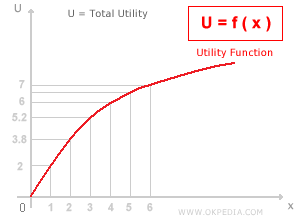Diminishing Marginal Utility
Diminishing marginal utility describes the decline in the additional satisfaction a consumer derives from consuming successive units of a good. In analytical terms, the increase in utility, ΔU, resulting from an incremental rise in consumption, Δx, remains positive but decreases progressively. As consumption continues, the ratio ΔU/Δx approaches zero. Mathematically, this corresponds to a second derivative of the utility function that is less than zero. This relationship is typically illustrated using a downward-sloping utility curve:

As consumption of good X increases, each additional unit yields a smaller increase in utility - this is the essence of marginal utility. For example, the first unit of good x (x=1) might generate an increase in utility of ΔU=2; the second unit (x=2) yields ΔU=1.8; the third (x=3) only ΔU=1.4, and so on. This diminishing return can also be illustrated by plotting marginal utility directly on the vertical axis, rather than total utility:

Diminishing marginal utility is a foundational concept in economics, first developed in the 19th century by thinkers such as Nassau William Senior. It became a central pillar of early consumption theory through the contributions of Jules Dupuit and Hermann Heinrich Gossen. The principle also underpins key developments in utilitarian and marginalist thought, influencing economists like William S. Jevons, Léon Walras, and Alfred Marshall. Jevons used it to construct a theory of exchange grounded in individual marginal utility functions; Walras incorporated it into his general equilibrium framework; and Marshall applied it to the development of a utilitarian theory of welfare.

Law of Satiable Wants. According to this principle, the intensity of a given need diminishes as that need is increasingly satisfied. The law of satiable wants provides the theoretical foundation for diminishing marginal utility.
